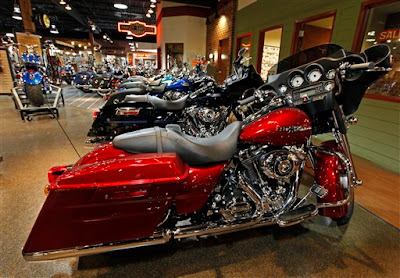Harley-Davidson 1Q profit drops, plans job cuts
DAN STRUMPF
AP Auto Writer
But the Milwaukee-based company beat Wall Street expectations and stood by its full-year forecast for motorcycle shipments, sending shares higher in afternoon trading.
Harley, which is in the midst of a restructuring effort announced three months ago, said it planned to cut between 300 and 400 additional factory jobs over the next two years. That brings the total expected cuts, including white-collar reductions, to between 1,400 and 1,500 over that period.
“Every reduction in work force we look at very carefully,” said Jim Ziemer, the company’s outgoing chief executive, in an interview. “We need to manage the business to make sure we’re well positioned to grow when the economy turns around.”
Harley, the top seller of heavyweight motorcycles in the U.S., has hit a rough patch recently amid the economic recession, as consumers put off purchases of its classic, high-end bikes. In January, the company launched a restructuring effort involving shutting down some facilities, consolidating others and — at the time — cutting 1,100 factory and white-collar jobs.
Ziemer said he is confident Harley will emerge stronger following the tough market and offered a farewell to analysts and investors during the company’s quarterly conference call. Ziemer will retire from Harley at the end of the month after 40 years at the company and four years at the helm. Keith Wandell, the chief operating officer at Milwaukee-based Johnson Controls Inc., will succeed him starting May 1.
“Leading this company has been a true privilege — both when times were booming and in times of adversity,” Ziemer said.
Harley earned $117.3 million, or 50 cents per share, in the three months ended March 29, down from $187.6 million, or 79 cents per share, a year earlier.
Revenue slipped 2 percent to $1.29 billion from $1.31 billion.
The company said it took a pretax charge of $34.9 million during the quarter due to restructuring costs and a charge of $22.5 million due to a change in Wisconsin tax law that occurred mid-quarter. The company declined to say what it earned without those charges.
But Robin Farley of UBS Investment Research estimated Harley would have earned 76 cents per share excluding those and other items, while Greg Badishkanian of Citi Investment Research said the company would have earned 69 cents per share without the tax and restructuring items.

Wall Street analysts surveyed by Thomson Reuters expected earnings, on average, of 51 cents per share on $1.28 billion in sales. Such estimates typically exclude one-time items.
Despite the weaker quarter, Harley said its rate of sales decline has slowed. The company also outperformed the broader industry and captured additional market share, as other motorcycle makers face even bigger sales drops. Harley’s U.S. sales fell 9.7 percent in the first quarter, the company reported, while industrywide sales of heavyweight bikes in the U.S. fell 22.3 percent.
“Their brand is still resonating and can do well even in some economic softness,” said Robin Diedrich, senior consumer analyst at Edward Jones.
Globally, Harley said its sales fell 12 percent year-over-year, as the economic downturn spread to its overseas markets. The company has been aggressively pushing its bikes overseas, including in Latin America, Europe and China, as it seeks to offset slowing sales at home.
Tom Bergmann, Harley’s chief financial officer, said during a conference call that he was confident the company’s financing arm would be able to meet its funding needs for the year. The company’s decision in February to cut its dividend, coupled with a $600 million debt offering and other financing efforts, should cover the division’s $1 billion in needed funding.
“I expect 2009 to continue to be a tough year, but believe we have a strong team in place,” Bergmann said.
Like all vehicle financing arms, Harley-Davidson Financial Services has come under serious strain recently. The division has traditionally funded itself by making loans to motorcycle customers, then bundling and selling those loans to investors as securities. But the securitization market has dried up in the economic recession, so the company has had to turn to other sources to pay for its operations.
Operating income at HDFS plunged 68 percent to $11.2 million during the first quarter, the company said.
Harley said it is standing by its plan to ship between 264,000 and 273,000 motorcycles to its dealers in 2009. The company announced the shipment guidance — which is a 10 percent to 13 percent decrease from 2008 shipments — three months ago.
Harley announces quarterly and yearly forecasts for motorcycle shipments, which provide industry watchers with a glimpse at how it expects sales to perform. The company aims to keep shipments in line with sales to prevent an inventory glut, which adds to costs and damages its coveted image.
Harley said it plans to ship between 55,000 and 59,000 motorcycles during the second quarter.
Shares of Harley-Davidson gained 98 cents, or 5.7 percent, to close at $18.11 Thursday.
No comments:
Post a Comment